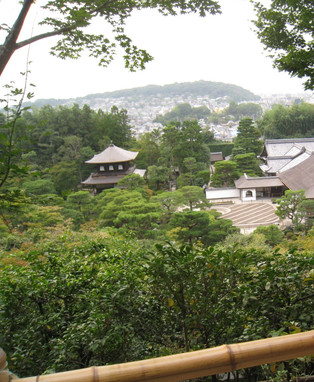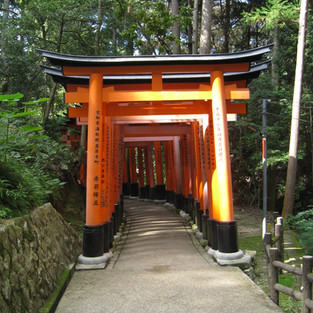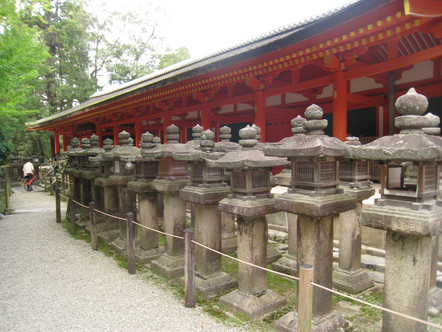Japan in Autumn
- rabbitmum

- Apr 17, 2018
- 11 min read
Updated: May 25, 2018
I've always been fascinated by Japan - everything about it. It's been in my bucket list for long. We decided to go to Japan for the first leg of our honeymoon (second leg was Phuket, Thailand). We went to Tokyo, Hakone, Kyoto, and Osaka for 9 days (8 nights). It was such an experience to visit Japan and to see Japanese – they’re very unique (in a very good way :-)) and we saw things we’ve never seen before.
We did our own itinerary but we used JTB (Travel Agency) to get our rail passes and booked hotels. I was informed that it's cheaper to get the rail passes from outside Japan.

We landed in Tokyo in the afternoon and using airport transfer (taxi is very expensive in Japan!) we went straight to our hotel, Keio Plaza. After checked-in, we walked to an eating area near our nicely located hotel and had ramen (for me) and yakisoba (for my husband) for dinner. Yummy! Our first Japanese meal in Japan. We had a bit of a walk around the area and had dessert - oh yes, we both are dessert people. We had our first moment of lost-in-translation here when we wanted to pay the bill and the polite, patient, and smiling waitress kept on saying to us "sorry, one bill system" - which we didn't understand what she meant to say.
(What does that street sign on the bottom right mean? We had a lot of fun looking at unusual street signs and tried to guess what they mean)
On the first day exploring Tokyo, we took a train to go to Hama-Rikyu Gardens, a landscape garden in central of Tokyo, where we visited a Tea House and experienced Japanese Tea Ceremony. Some of the rules:
How to hold the bowl? The bowl is placed in front of you with the facade (the surface that has some pattern) facing you. Take the bowl on your right hand and place it on your left palm.
Which side to drink? With the bowl still on your left palm, use your right hand to turn your bowl clockwise twice so that the pattern of the bowl is facing the opposite side instead of facing you.
How many sips do we take? The host of the tea ceremony usually prepare the tea in the quantity of 3-4 sips. If possible, try to finish your tea until there is no more foam left in the bowl.
From Hama-Rikyu Gardens, we too a cruise along Sumida River heading to Asakusa to visit an ancient buddhist temple, Sensoji Temple. It is Tokyo's oldest temple, and one of its most significant. There were O-Waraji - a pair of huge (2,500 kg and 4.5 metres long) traditional straw sandals made by 800 citizens of Murayama City in a month and devoted to Sensoji. They are the charm against evils.
We took a stroll in the small streets surrounding the temple - very lovely - and had Unagi with Rice for lunch. Very delicious!
From Sensoji Temple we went to Tokyo Tower, a communications and observation tower. It is the second-tallest structure in Japan standing at 332.9 metres. We went up to get a nice view of the city. We also viewed the bottom of the tower from up there through the look down window.
At the foot of Tokyo Tower, there is this very beautiful restaurant with Japanese garden landscape, called Tokyo Shiba Tofuya Ukai.
We ended our day with a visit to Harajuku, to see the youth style and fashion.
We woke up very early (4 am! yawning!) and took an expensive taxi ride (we had no choice as there was no train yet that early) to go to Tsukiji Fish Market, the biggest wholesale fish and seafood market in the world. By the time we arrived there around 4.45 am, we could only manage to get in to the 2nd slot of the tour - which meant others got there much earlier than us. There were only two slots available each day. We had another lost-in-translation moment while queueing. We saw a notification on the board saying:
It is not appeared forth with having worn a best.
When I go out, I leave the best with a companion, and please appear.
Please do not take the best home with you.
Anyway... :-) After a long wait, finally it was our turn. We looked around the fish market and observed the tuna auction process. There were so many tunas put there on the floor with their tag (label / number / code - I don't know!) and the buyers (all men!) held a torch inspecting the tuna and made a note which one they wanted to buy. Then the auction process started. It was very interesting.
We already planned to have sushi for breakfast, but there're many restaurants in the fish market. We chose the one with the queue. It was a very small place, only less than 15 seats. The sushi were really good and fresh. Not cheap, though.
We came back to our hotel, had a shower (yes, we brought the smell from the fish market), checked-in and went to the train station to continue our journey to Hakone, a mountainous town known for its hot springs resorts (onsen) and views of the iconic volcano Mount Fuji. We stayed in a ryokan called Yaeikan. There was a shuttle bus that took us from Hakone-Yumoto train station to the hotel. After checked-in our ryokan (oh the bathroom was really really tiny!), we left the hotel and walked around. We took a bus to Hakone Detached Palace (Kyū Hakone Rikyū), located at the southern shores of Lake Ashinoko on the peninsula between Moto-Hakone and Hakone-machi. The palace used to be used as a summer palace for the imperial family, but later opened for public. It is surrounded by a beautiful park, known as Onshi Hakone Park. We went to the look-out point but unfortunately when we were there, the visibility of Mount Fuji was not good. It was foggy.
We came back to the hotel and had a Japanese dinner in the hotel - in yukata, a kind of Japanese traditional Kimono but casual one. We had to make up our futon (bedding) before sleeping on tatami.
The view from our hotel was amazing. Look at the greeneries! It was so beautiful and calming. After breakfast (with this amazing view), we headed to the train station to continue our journey. In the station, we looked for some bentos (oh! so appetizing) for our train trip to Kyoto.
We took a shinkansen from Hakone to Kyoto, where we stayed for three nights. We checked-in at Citadines Karasuma-Gojo serviced apartment, located very close to Gojo train station. Gojo train station is only one station away from Kyoto main station.
(It is important to choose a hotel that is near a train station, make your commuting easier and more pleasant. We did this too for our Winter in Switzerland and Germany trip).
In the afternoon, we went to Ginkakuji (Temple of the Silver Pavillion) by bus. I enjoyed seeing Japanese style garden landscape. It has unique dry sand garden and one of the essential element of the garden is the pile of sand which is said to symbolize Mount Fuji. We then took a leisure walk along the canal in Shishigatani area, a very lovely and enjoyable leisure 1-hour walk to Gion. We passed little shops, houses, and also Otoyo Shrine. Very charming! I am sure it would be even more charming during spring.
We had another delicious dinner in Gion before headed to Gion Corner to see seven kinds of traditional performing arts (Tea Ceremony, Koto Harp, Ikebana Flower Arrangement, Gagaku Music, Kyogen the Ancient Comic Play, Kyomai Dance, Bunraku Puppet). After the performance, we walked around the area. It's nice and clean and I really enjoyed looking at the Japanese houses. We saw many Geisha walking around.
On our second day in Kyoto, we went to Fushimi Inari-Taisha - the head shrine of the god Inari, located in Fushimi Ward. It is said that Inari is the god of rice, but merchants and manufacturers have traditionally worshiped Inari as the patron of business. Fox statues were found in various locations in Inari shrines.
After spending some time here, we moved to Kiyomizu Dera Temple, about 5 km north of Fushimi Inari-Taisha. Kiyomizu Dera is a buddhist temple and it is part of the Historic Monuments of Ancient Kyoto UNESCO World Heritage site. I was hoping to see yellow-orange colour leaves but we came a bit too early for that. We had lunch in the street just outside the temple.
We then took a stroll around Higashiyama Area where we found Hokanji Temple, a 5-storey buddhist pagoda temple. I really liked the neighbourhood - the small and clean cobbled alley streets with Japanese style houses. Further north from Hokanji Temple, about 650 metres away, there's another a place called Yasaka Shrine (also known as Gion Shrine), one of the famous shrine in Kyoto. The shrine includes several buildings, including gates, a main hall and a stage with hundreds of lanterns.
On our third day in Kyoto, we visited Nara, about 50 km south from Kyoto central station. Once arrived at Nara train station, we rented bicycles. Nice area to cycle! Our first stop was Kofukuji Temple, one of the city's most beautiful and historic temples and a UNESCO World Heritage Site. Within the compound, we sighted 3-storey Pagoda, North Octagonal Hall, South Octagonal Hall, 5-storey Pagoda, East Golden Hall. We continued to cycle passed a pond and had lunch at an Okonomiyaki restaurant. Delicious!
We continued to cycle, passed Tsubomiwa Shrine and the deers before finally arrived at Kasuga-taisha, a Shinto shrine. The interior is famous for its many bronze lanterns, as well as the many stone lanterns that lead up the shrine. Kasuga Shrine, and the Kasugayama Primeval Forest near it, are registered as a UNESCO World Heritage Site as part of the "Historic Monuments of Ancient Nara".
From Kasuga-taisha, we cycled to Nigatsu-dō (The Hall of the Second Month), one of the important structures of Tōdai-ji (our next stop) that is located on the hillside of Mount Wakakusa. From its balcony, we enjoyed the beautiful view of Nara. With a short bicycle ride, we reached Tōdai-ji, Nara's most popular tourist attraction and a UNESCO World Heritage Site. Inside its Great Buddha Hall, we saw a really huge bronze statue of the Buddha. Deer, regarded as messengers of the gods in the Shinto religion, roam the grounds nearby the temple freely. While Todai-ji it's a very magnificent temple and a must visit place when you are in Nara, I prefer "smaller" ones Nigatsu-do and Kasuga-taisha.
We had a really lovely day in Nara. It was very enjoyable - the cycling, the temple hopping, the park, and the deers.
On our last night in Kyoto, we spent some time in the supermarket checking out food :-) They looked nice and pretty and so appetizing - and some of them were so expensive (like 5,000 yen melon!) . We chose ramen for our dinner.
We continued our journey by train to Osaka. We reached Osaka station - and amazed with number of exits they have (25 exits?!) and not all the exits have lifts. So yeah we had to take our luggages by stairs (lots of them). Good exercise! We took Midosuji line to Namba station (it's just four station away from Osaka station) and a short walk about 400 metres from the station brought us to Cross Hotel, where we stayed for two nights.
(Oh that Japanese toilet in our hotel with many button was amusing :-) I enjoyed using this sophisticated toilet).
We asked the hotel for food recommendation and they showed us Hokkyokusei Restaurant, a very short walk from the hotel. From outside, it looked as if it's a small restaurant but once we're inside, it's actually quite big and spacious with a mini garden inside. We had omurice and they tasted soooo good! Highly recommended.
After lunch, we headed to Osaka Castle, one of Japan's most famous landmarks. We spent some time in the Osaka Castle Museum to see the artifacts on display and read the history - as well as viewed Osaka city from the observatory deck on the top floor located 50 metres above the ground.
The next morning, we went to Himeji by train, about 100 km west of Osaka. We planned to visit Himeji Castle located in the top of the hill but the gorgeous castle was under renovation for at least 4 years and the main part was closed. We were so disappointed. We could still viewed the some part of the castle and also the outer part. Luckily the garden next to the castle, Koko-en Garden was so beautiful. It was constructed in 1992 to commemorate the 100th anniversary of the establishment of the Himeji municipality.
The last night in Osaka, we looked at some more food (our hobby :-)) The Manneken waffle we found at the train station was so good, we bought it a few times during our stay in Japan. The sushi and bento boxes looked extremely pretty and appealing and smelt nice too! Honestly, looking at the photos again and thinking about the food in Japan now make me drooling. They're sooo good.
(What is Manner Station? :-))
It's time to say good-bye to Japan. What a great 9 days!
I always love to make observation and take some note wherever I go and here they are from my time in Japan:
1) Japanese like very warm room temperature and this was definitely too hot for me! I can’t stand being inside the room in Japan – in the airport, hotel lobby, restaurant, train station – simply too hot for polar bear like me!
2) Still related to the first point, whenever they go outside the building, they dressed up as if it was winter while actually it was only 22-23 degree celcius. I looked like a crazy girl wearing sleeveless or thin T-shirt while they’re all wrapped with sweater. Now I understand why this Japanese girl in my office always wear long sleeves with cardigan with legging under her shirt and then with blanket to cover her legs.
3) Japanese are very friendly and very helpful and very polite. It’s so nice to talk to them, buying something from them, or ask for direction. They are not grumpy and not mean. They always smile :-)
4) They don’t really speak English even in the tourist office but it doesn’t matter because they’re really helpful and friendly.
5) Somehow I always had imagination that Japanese like to say “Sayonara” to say good-bye to each other. We hardly heard that when we were there! So “sayonara” is no longer the word. It is “bye-bye”.
6) The trains and even buses are so on-time – definitely beat the timeliness of German’s trains.
7) One thing I still can’t figure out – some buses always turned-off the machine whenever they stopped even for very short period, like for example at the traffic light or to alight passengers.
8) There is no possibility of you dehydrated in Japan! You can find vending machine selling drinks almost every few metres. Even in the middle of nowhere, we found one.
9) Japanese seem to be a very heavy coffee drinker and they seem to like drinking coffee from the can – from vending machine. There’re many different brands for canned coffee.
10) One thing I still don’t understand is the price of big can of coca cola (500-ml) and small can of coca cola (250-ml) is the same! Same with mineral water. How does it work??
11) Obviously they like vending machine so much – not only for drinks, we also found vending machine for ice cream (Haagen Dazs) and even newspaper!
12) Relative to their body size, they have short (and relatively) fat fingers. Don’t ask me why – this was my observation.
13) Japanese like to dress-up formally even for a leisure walk.
14) We had to walk a lot in Japan – most temples are located on the hill and most train stations don’t have escalator. I’ve never done so much walking within consecutive 8 days in my whole life!
15) Quite similar like in Seoul (Korea), the car colours are so boring – white, silver, black, grey… didn’t see any red or orange or yellow or green.
16) All the taxi’s seat are covered with grandma’s tablecloth material :-)
17) I admire whoever invented the very fancy toilet in Japan, especially the seat warmer! Love it! :-)
18) Everybody likes fluffy things – girls and boys, women and men, young and old – they put fluffy key-chain on their bag and mobile phone. Sometimes not only one key-chain but could be three or four or five!
19) We saw quite number of people with small dogs like Chihuahua or Poodle – not big dogs like in Madrid. I guess because houses in Japan are small… they can only keep small dogs.
20) Japanese foods are so yummy and nicely packed – beautiful and clean. Even the mini market’s food taste really nice. Almost every morning, we bought our breakfast from the mini shop at the train station… onigiri (my favourite) and chicken katsu sandwich (my husband's).
We love Japan (and Japanese food) and we will definitely come back – hopefully this time at the right seasons, when leaves turn yellow/orange (my wish), during cherry blossom (my wish) and when ice sculpture is on the show and we can ski (my husband's wish)… ok, so this means we’ll have to come back at least three times… autumn, spring, and winter :-) - which I don't mind at all.
Happy Travelling!











































































































































































Comments